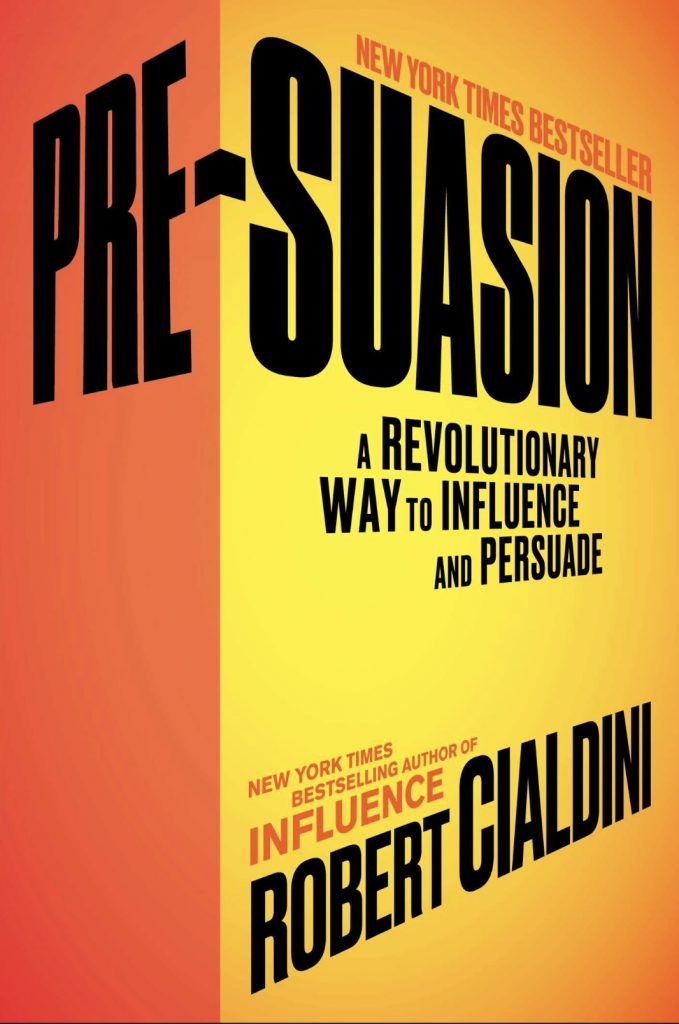Key Quote:
“Anything that is self-connected gets an immediate lift in our eyes. Sometimes the connections can be trivial but can still serve as springboards to persuasive success” (p. 110). — Robert Cialdini
Key Points and Concepts
Privileged Moments
“The highest achievers spent more time crafting what they did and said before making a request. They set about their mission as skilled gardeners who know that even the finest seeds will not take root in stony soil or . . . poorly prepared ground” (p. 4).
Cialdini learned palmistry to use as an icebreaker but discovered its insight into pre-suasion. People typically look for similarities rather than differences, so telling someone that their palm says they’re stubborn might invoke them to search their memory for examples of stubbornness. He mentions one specific party where he told the host, at two different points in the evening, that he was both stubborn and flexible. The host agreed with him both times (p. 21).
Asking the question “Do you consider yourself a helpful person?” as opposed to asking mall goers for a few minutes of their time increased participation in a survey from 29 percent to 77.3 percent. “Following brief reflection, nearly everyone answered yes. In that privileged moment–after subjects had confirmed privately and affirmed publicly their helpful natures–the researchers pounced, requesting help with their survey” (p. 25). Similarly, asking someone if they consider themselves to be “somebody who is adventurous and likes to try new things” invoked an increase in trying a free sample from 33 percent to 75.7 percent (p. 26).
The Importance of Attention . . . is Importance
“Whatever we can do to focus people on something–an idea, a person, an object–makes that thing seem more important to them than before” (pp. 29-30).
When handling multiple channels of information, the human mind appears to hold only one thing in conscious awareness at a time. For example, when intently looking for a highway exit, you stop hearing the music playing in your car (p. 28).
Due to the embedded reporter program of the war in Iraq, which focused almost entirely on the troops-their daily activities, food, clothing, supplies, and the bravery they showed in battle-the public’s attention was shifted from the larger rationale for the war to its daily execution. Although the initial justification for the war had been debunked, (which was to rid the region of weapons of mass destruction) 71 percent of front-page war coverage came from embedded journalists with a focus on soldiers and soldiering, which set the media agenda to individual actions and battlefield outcomes versus those related to initial justifications and geopolitical ends (pp. 48-49).
“Issues that gain attention also gain presumed importance. Some of that same research demonstrates that if people fail to direct their attention to a topic, they presume that it must be of relatively little importance” (p. 48).
What’s Focal Is Causal
Factors that we have at our attention we assign to elevated importance; we also assign them causality (p. 51).
When a researcher approached people waiting in line at different venues and offered them money in exchange for cutting in line, unsurprisingly the more money offered, the more people agreed. The surprising outcome was that almost no one actually took the money. By offering more money to cut in line, the people in line assigned more importance on the other’s need to cut. “Elements such as money that attract notice within human exchanges don’t just appear more important, they also appear more causal. And presumed causality, especially when acquired through channeled attention, is a big deal for creating influence” (p. 53).
In 1982, someone in the Chicago area was injecting packaged capsules of Tylenol with cyanide, which killed 7 people and made headlines around the country. Unsure of the cause, Johnson & Johnson issued nationwide warnings including lot numbers on the affected bottles.
These lot numbers immediately become such popular lottery numbers that three states had to halt wagers on them. “Because of all the publicity surrounding them, they had become focal in attention; and what is focal is seen to have causal properties–to have the ability to make events occur” (p. 54).
This what’s-focal-is-presumed-causal effect is also explained with those who are pressured into false confessions. Once a confession is made, it becomes the focal point, and all other evidence becomes less important (p. 60).
The practice of taping interrogations/confessions so others can assess for themselves whether the confession was gained improperly or not is a good practice, however it has a major problem. “A camera angle aimed at a suspect during an interrogation leads observers of the recording to assign the suspect greater responsibility for a confession (and greater guilt) . . . with the camera trained over the suspect’s shoulder onto the interrogator’s face, the interrogator was perceived to have coerced the confession. Manifestly here, what’s focal seems causal” (p. 64).
Commanders of Attention
Whenever we first register a change around us, our attention flies to it. Cialdini explains why when we walk into another room, we forget why we made the trip. “Walking through door-ways causes you to forget because the abrupt change in your physical surround redirects your attention to the new setting–and consequently from your purpose, which disrupts your memory of it” (p. 78).
This reaction was seen in Pavlov’s dogs classical conditioning study. Pavlov wanted to show his discovery to others; however, when moved into a new space with new visitors, the dogs did not salivate to the sound of the bell as the new stimuli hijacked the dog’s attention (pp. 76-77).
Linking and Associating
“Anything that is self-connected (or can be made to seem self-connected) gets an immediate lift in our eyes” (p. 110).
This implicit egoism is shown with the significant boost in sales Coca-Cola saw when branding their products with the 150 most common first names, showing this general tendency to value entities linked to the self. People also prefer individuals, as well as products, that share names, letters, and initials (p. 110).
Similarly, exposing individuals to words that connote achievement increases their performance and willingness to keep working. Including images associated with achievement-related thinking, such as a runner winning a race, have the same effect (p. 104).
Reciprocation and Kinship
The rule for reciprocation states that those who have given benefits to us are entitled to benefits from us in return, showing that people often say yes to those they owe (p. 153).
When a restaurant offered a small item for free when visitors came in, studies showed that their sales increased, even though in theory visitors would be less hungry. This upfront gift activated not only the rule for reciprocation, but also that people felt especially obligated to reciprocate a gift designed to meet their particular needs–in this case, hunger (p. 156).
When interrogating Osama bin Laden’s former chief bodyguard, interrogators noticed he never ate the cookies provided with his meal and after learning this was because he was diabetic, they provided sugar-free cookies. According to one of those interrogators, that was a key turning point and subsequently the bodyguard started providing extensive information (p. 157).
When using words that create familial images–i.e., brothers, sisterhood, forefathers, motherland, heritage–people’s willingness to engage and sacrifice their own interest for the group increased. Cialdini uses a personal example of how he felt this effect when he received an annual letter from Warren Buffett that addressed shareholders of Berkshire Hathaway Inc. “I will tell you what I would say to my family today if they asked me about Berkshire’s future” (pp. 178-180).
When Cialdini wanted his students’ parents to complete a lengthy questionnaire, he offered an extra point on the next test to each student whose parent responded. 97 percent mailed back a completed copy. In contrast, adult participation in such surveys is typically below 20 percent (p. 177).
When Nazi officials pressured Japan to engage in horrendous acts to their Jewish population, members of the Japanese High Command asked leaders of the Jewish refugee community why they should continue to protect them from the Nazis. They responded, “Because we are Asian, like you”. Implicating the Nazis’ own racial claim that the superior Aryan master race was innately different from the peoples of Asia. The rabbis were assured they had nothing to fear while in Japanese territory (pp. 189-191).
Another study asked participants to listen to an array of recorded audio tones on headphones and tap the table to the beat. One group listened to the same tones as a partner, while another group listened to a different set of tones as their partner. One group tapping in synchrony, the other not. Afterwards, when asked if they would stay to help their partner on some other task, 49 percent who tapped in synchrony chose to stay and help, while 18 percent of those who did not tap in synchrony chose to leave. An example of this being implemented is military marching (pp. 196-197).
Ethical Use
Cialdini addresses the ethical question of this effective persuasion, asking if he is doing more harm than good by giving certain unethical practitioners the means to take advantage of consumers. He advises that although such tactics might increase profit in the short run, once exposed, they will produce unacceptably high costs. Consumers’ trust in a company is paramount and rebuilding that trust is extremely difficult and could take years, in which time consumers and clients are likely to have established links to rivals. He cites Volkswagen’s diesel emissions scandal, where the automaker’s sales dropped to one-sixteenth of industry average and their reputation among vehicle owners went from 70 percent favorable to 80 percent not favorable (p. 212).
Even if the ethical misconduct of a business or organization isn’t made public, Cialdini shows that it can severely damage the internal workings. For most employees, the more unethical the climate, the poorer the workers’ job performance, the more stress they felt at work, and the more they looked to leave. The cost of employee turnover is a significant loss to companies (p. 218). For the employees that prefer the unethical climate and choose to stay, studies have shown that they are more likely to engage in altering expense reports, sabotaging equipment, avoiding work, and using company resources for private purposes (p. 221). “Those who cheat for you will cheat against you” (p. 219).
Cialdini, R. (2016). Pre-Suasion: A Revolutionary Way to Influence and Persuade. New York: Simon & Schuster.

Asking the question “Do you consider yourself a helpful person?” as opposed to asking mall goers for a few minutes of their time increased participation in a survey from 29 percent to 77.3 percent.
When interrogating Osama bin Laden’s former chief bodyguard, interrogators noticed he never ate the cookies provided with his meal and after learning this was because he was diabetic, they provided sugar-free cookies. According to one of those interrogators, that was a key turning point and subsequently the bodyguard started providing extensive information.
Even if the ethical misconduct of a business or organization isn’t made public, Cialdini shows that it can severely damage the internal workings. For most employees, the more unethical the climate, the poorer the workers’ job performance, the more stress they felt at work, and the more they looked to leave.
